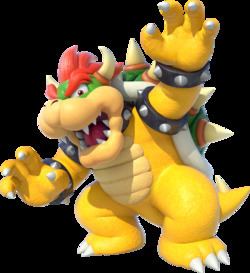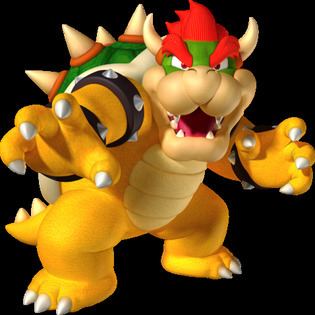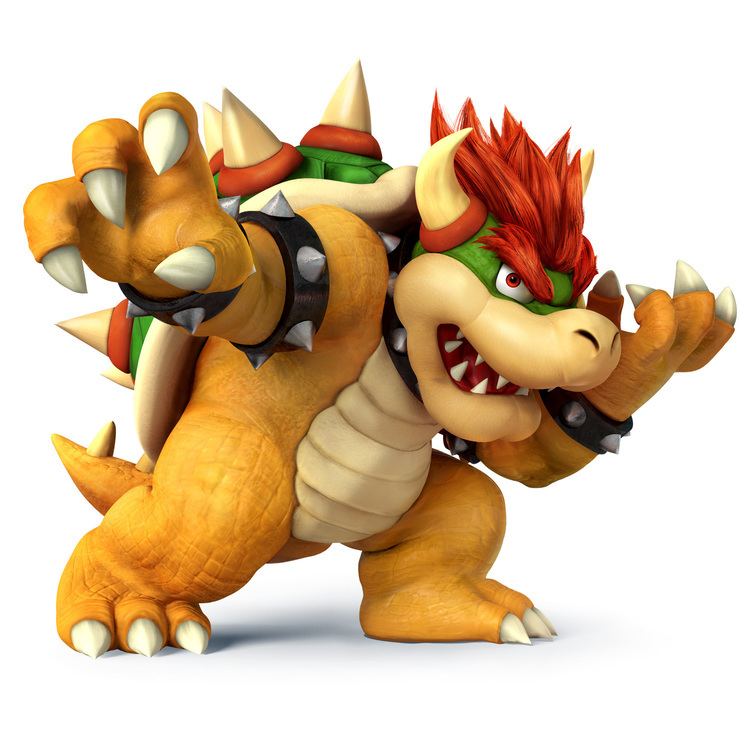Created by Shigeru Miyamoto Creator Shigeru Miyamoto Fictional universe Nintendo Universe | Played by Dennis Hopper First game Super Mario Bros. (1985) | |
 | ||
Designed by Shigeru Miyamoto
Yōichi Kotabe Voiced by (English) Marc Graue (1994)
Scott Burns (2002–2010)
Eric Newsome (2007–2008)
Kenny James (2005; 2007–present)
Harvey Atkin (The Super Mario Bros. Super Show!, The Adventures of Super Mario Bros. 3, and Super Mario World)
Fred Tatasciore (MAD) Voiced by (Japanese) Naoki Tatsuta (BS Super Mario Collection)
Akiko Wada (Super Mario Bros.: The Great Mission to Rescue Princess Peach!)
Masaharu Satō (Amada Anime Series: Super Mario Bros.)
Takanobu Hozumi (Japanese DVD dub of Super Mario Bros film)
Hiroshi Arikawa (Japanese Nippon TV dub of Super Mario Bros Film) Portrayed by Christopher Collins/Patrick Pinney (King Koopa's Kool Kartoons)
Dennis Hopper (Super Mario Bros.) Movies Super Mario Bros., The Roast of Mario Affiliations Mushroom Kingdom, Bowser's Castle Similar Mario, Luigi, Princess Peach, Yoshi, Toad | ||
Bowser (クッパ, Kuppa, "Koopa") or King Koopa is a fictional character and the main antagonist of Nintendo's Mario franchise. In Japan, the character bears the title of Daimaō (大魔王, Great Demon King, lit.). In the United States, the character was first referred to as "Bowser, King of the Koopa" and "The sorcerer king" in the instruction manual. Bowser is the leader and likely the most powerful of the turtle-like Koopa race, and has been the archenemy of Mario ever since his first appearance, in the game Super Mario Bros.
Contents
- Concept and creation
- Characteristics
- Voice and portrayal
- Super Mario series
- Other games
- In other media
- Reception and legacy
- References

His ultimate goals are to kidnap Princess Peach, defeat Mario, and conquer the fictional Mushroom Kingdom. Since his debut, he has appeared in almost every Mario franchise game, usually serving as the main antagonist. Bowser has been called "the most successful video game character". Currently, Bowser is voiced by Kenny James. In addition to his usual animated and video game appearances, he also appears in the 1993 highly criticized live-action film, where he is portrayed by Dennis Hopper.

Concept and creation
Bowser was the creation of Nintendo designer and producer Shigeru Miyamoto Miyamoto had first envisioned Bowser as an ox, basing him on the Ox King from the Toei Animation film Alakazam the Great. However, Nintendo designer Takashi Tezuka pointed out that the character looked a lot more like a turtle than an ox. Miyamoto and Tezuka then began to work together to define Bowser's appearance. Since the character was the leader of the turtle-like Koopa Troopas the two began to base his new appearance on them, creating a new illustration. In his final design, Miyamoto commented that he could make Bowser "look cool now".
Miyamoto named him 大魔王 クッパ Daimaō Kuppa. Kuppa came from the Japanese name for 국밥, gukbap, a Korean dish. Miyamoto had also considered the names ユッケ Yukke and ビビンバ Bibinba, also Japanese names of Korean dishes (육회 yukhoe and 비빔밥 bibimbap respectively). The Korean name for the character Bowser/Kuppa is not Gukbap, but 쿠파 Kupa, which is essentially a phonetic round-trip translation. The name was anglicized Kuppa rather than Koopa in the Japanese versions up until the release of Super Mario World.
In the Super Mario Bros. film, Bowser is called President Koopa and is portrayed by Dennis Hopper. He is also briefly referred to as King Koopa. In the film, he is almost entirely human in appearance, with blonde hair he gels in the shape of a crown, and he frequently wears a black business suit and tie. However, after being briefly exposed to his own Devo machine by the Mario Bros., he starts occasionally possessing some reptilian traits. The final climax of the film sees Koopa devolve into an enormous Green Tyrannosaurus Rex to battle the Mario Bros, but he is de-evolved into primordial ooze.
Characteristics
Bowser is portrayed as the "King of the Koopas", anthropomorphic turtles that inhabit the world of the Mushroom Kingdom. Bowser differs greatly from the rest of the Koopa clan, which consists mainly of bipedal tortoises. His is characterized by a large, spiked turtle shell, horns, a draconic snout, razor-sharp fangs, taloned fingers, three clawed toes on each foot, and a shock of red hair. He is physically powerful, nearly indestructible and can breathe fire. He can also jump surprisingly high for his large size, although his speed and agility are most of the time lacking.
Bowser's physical size tends to vary from game to game. In most games, he towers over the majority of characters, but there are exceptions. In Super Mario RPG, he stands only slightly taller than Mario. He is shown changing his size at will or through others' sorcery in games including Super Mario World 2: Yoshi's Island, Super Mario Galaxy and Super Mario Galaxy 2.
Bowser aspires to take over the Mushroom Kingdom and merge it with his own realm. He is infatuated with Princess Peach, and routinely kidnaps her as part of his plans for domination. Sometimes, he kidnaps Peach simply to lure Mario into a trap, but occasionally he hopes to marry her.
The character's role in the franchise varies. He is typically the main antagonist in the main series, but in the RPG series, he sometimes works with the heroes to defeat a greater evil. The RPGs also portray Bowser in a more humorous light as a blustering, buffoonish bully with a hidden softer side. He also cares for his minions.
Bowser also has a son, Bowser Jr., who helps his father kidnap Princess Peach. Bowser Jr.'s mother is unknown, as Bowser isn't officially confirmed as having a previous marriage yet. Originally in Super Mario Bros. 3, Bowser was stated to be the father of the Koopalings with subsequent official sources adding that he was their biological father, but since their return in New Super Mario Bros. Wii they have been referred to as Bowser's minions and in an interview held in 2012 Shigeru Miyamoto stated that "Our current story is that the seven Koopalings are not Bowser's children. Bowser's only child is Bowser Jr., and we do not know who the mother is.".
Voice and portrayal
Up until the release of Super Mario Sunshine, Bowser's voice consisted of mostly computer generated roars, snarls, and laughs. Then, in the 2002 release of Super Mario Sunshine, radio personality and voice actor Scott Burns gave Bowser his first spoken dialogue and continued portraying him for several more years. With the late 2005 release of Super Mario Strikers, Kenneth W. James became the new voice actor for Bowser. Although, for a few years, old recordings of Burns were reused for games after James took the role, such as "Mario Party DS". Between Burns and James, however, Bowser was briefly voiced by Eric Newsome in Super Paper Mario.
Super Mario series
Bowser's first appearance was in Super Mario Bros. as the main antagonist who kidnaps Princess Peach and as the final boss with several false versions of him appearing as lesser bosses. In addition to breathing fire, he also throws hammers in later levels, similar to the Hammer Bros. He reappears in Super Mario Bros.: The Lost Levels, in which he uses the same battle tactics as in the previous game. Although he was absent in Super Mario Bros. 2 (where he was replaced by Wart as the final boss), he appears in Super Mario Bros. 3, and along with the Koopalings, he transforms the kings of seven worlds into various different creatures and eventually capturing Princess Peach yet again. Bowser and his seven koopalings reappear in Super Mario World, where they conquer Dinosaur Land and kidnap Peach while she and Mario are on vacation on Yoshi's Island. He makes his first 3D appearance in Super Mario 64, where he takes over Peach's castle and steals 120 Power Stars (150 in Super Mario 64 DS), scattering them through various worlds linked using the castle. He returns in Super Mario Sunshine, in which his youngest, but favorite son, Bowser Jr., who is disguised as an evil version of Mario, kidnaps Peach. Bowser himself eventually appears in the final boss battle of the game. In New Super Mario Bros., Bowser is the boss of the first world, which features a battle similar to that of Super Mario Bros. After being defeated, he falls into lava and is reduced to a skeleton called Dry Bowser. He is eventually restored by Bowser Jr. and acts as the final world's boss along with his son. In Super Mario Galaxy, Bowser steals the Power Stars from Rosalina's Comet Observatory and kidnaps Peach, taking her to the center of the universe to recreate it, with the intention of taking over the universe. He also appears in New Super Mario Bros. Wii as the final boss and primary antagonist of the game. After being defeated at the end, he grows to a much greater size, chasing Mario through the castle by breathing fireballs before Mario defeats him again. Bowser appears in the sequel Super Mario Galaxy 2, once again as the main antagonist. Here, however, Bowser has grown to giant size, requiring the player to dodge more powerful attacks such as meteors and bolts of lightning. Bowser also appears in Super Mario 3D Land as the main antagonist once again where he steals Peach and uses the Super Leaf to create tailed minions. Dry Bowser also returns in this game as well. Bowser also appeared in New Super Mario Bros. 2 along with his Koopalings in order to capture Peach once more. Dry Bowser also makes an appearance in this game. Bowser returns as the main antagonist of New Super Mario Bros. and Luigi U along with the Koopalings and his son, but this time, they invade Castle Toadstool. Bowser returns once again in Super Mario 3D World as the main antagonist who is fought thrice, including as the final boss in a form known as Meowser, and this time, he will take over the Sprixie Kingdom by kidnapping the seven Sprixies so that he may steal the kingdom's treasures.
Bowser appears as a child in various games. Known as Baby Bowser (not to be confused with Bowser Jr.), he antagonizes the Baby Mario brothers and various members of the Yoshi species. He first appears in Super Mario World 2: Yoshi's Island where Kamek predicts the brothers will become problems in the future, so he attempts to kidnap them. He appears yet again in the sequel Yoshi's Story, stealing the "Super Happy Tree" from a group of Yoshis. He appeared yet again in Yoshi's Island DS as a playable character to recover his castle. Baby Bowser and his older self also appeared in Yoshi's New Island as the final boss. Baby Bowser makes an appearance in Yoshi's Wooly World as the main antagonist. Baby Bowser also appears alongside adult Bowser in early installments of the Mario Party series, typically as a flunky for adult Bowser but also stealing coins from players on the game boards.
In Super Mario Maker, Bowser can now be placed in any non-castle level. Although he cannot throw hammers, a winged Bowser Jr. can be stacked on top of him for that purpose. A Bowser costume can also be unlocked for use in the Super Mario Bros. style.
Other games
In other media
Reception and legacy
Due largely to the success of the Mario franchise, Bowser has become one of the most iconic and easily recognizable video game antagonists of all time. He frequently appears in lists for greatest video game antagonists. IGN placed him at #2 out of 100, and GamePro placed him at #9 out of 47. GameSpot listed him at #9 in their "Top 10 Video Game Villains" article, stating "Of all the villains to make an appearance on this list, Bowser...has got to be the most interesting," later adding "While some people say Bowser's life may have gotten into a rut, the man has simply refined his game down to an everyday thing. He's focused, he's dedicated, and worst of all, he's patient." Bowser ranked in the first slot on GameDaily's top 10 Nintendo characters that deserve their own games list, explaining if Yoshi and Wario get their own games, Bowser should too due to his being one of gaming's most nefarious villains. In GameDaily's top 10 Smash Bros. characters list, he ranked sixth. GameDaily also included him in their most persistent video game villains list. However, Bowser has been also rated as the 4th biggest douchebag in gaming history by ScrewAttack, who said that he wants to "take Mario down". IGN editor Craig Harris described Bowser as being a household name. In 2011, Empire ranked him as the 23rd greatest video game character while Guinness World Records Gamer's Edition 2013 featured Bowser first in their list of top 50 Villains.
Bowser's role in Super Mario Galaxy has been met with significant praise. Eurogamer editor Margaret Robertson commented that after years of being a "comedy villain", Galaxy put him back at his "scaly, scabrous best". PALGN editor Chris Sell called him the best boss in Mario Galaxy, stating that it wasn't just because of the battles with him being "superb, screen filling affairs", but also because he is "back to being mean again". Nintendo World Report editor Aaron Kaluszka commented that battling Bowser has never been "this intense and engaging". IGN editor Cam Shea praised his physical appearance in Super Mario Galaxy, describing him as "imposing and weighty". Another IGN editor, Matt Casamassina, praised the visual quality of the characters, citing Bowser in particular and mentioning how his "funky red fur waggles in the wind". Game Positive editor Travis Simmons concurred, commenting that his hair "gives him a touch of personality".
Bowser's role in Mario & Luigi: Bowser's Inside Story has been met with highly positive reception. He has frequently been referenced as the main character of the game due to his prominence in it. Eurogamer editor Christian Donlan commented that it felt good to play as Bowser, and that "After years of picking a path carefully around threats, jumping out of harm's way, and tackling challengers mostly from above, it's a pleasure to put those cares aside and relish a few hours of spiky, tortoise-shelled power." Destructoid editor Jim Sterling described Bowser's gameplay as "brilliant comic relief". He also described the dialogue of the game as being "laugh out loud funny", specifically praising Bowser's ego. RPGamer editor Michael Cunningham praised the game for Bowser "stealing the show", but also decried it for not having quite enough of him. Nintendo World Report editor Pedro Hernandez commented that the plot and humour of the game make iconic characters "more enduring, including Bowser". NGamer Magazine editor Matthew Castle commented that all Mario role-playing games make good use of Bowser, but that this is the first game where Bowser takes the center stage. Game Style editor Drew Middlemas commented that Bowser stole the show, being portrayed as a "creature of pure, blustering ego who reminds us of why he's one of gaming's greatest baddies." N-Europe editor called him the "real star" of the game, calling him a "fantastic character" with "so much more to give than what we’ve seen from him so far, even in the other Mario RPGs". He added that his "foul mood and lack of intelligence" as well as his interactions with other characters are well written. "
Kombo editor commented that he became a more sympathetic character as the game progresses, adding that his "massive ego pushes him towards heroism". Wired.com editor Chris Kohler called Bowser awesome, adding that his segments are funnier than Mario and Luigi's. Giant Bomb editor Brad Shoemaker states that Bowser steals the show, commenting that playing as him gives players an inside glimpse of his ego and megalomania. IGN editor Craig Harris described Bowser as the only "core Nintendo character over the past couple decades" to not have a starring role in a video game, and this game acts as his "big break". 1UP.com editor Jeremy Parish stated that Bowser makes the game, describing him as more interesting than Bowser's Inside Story predecessor's partners, the baby forms of Mario and Luigi. GamePro editor Alicia Ashby called Bowser one of the most "lovable characters in the Nintendo universe", and praising Bowser's Inside Story for giving him "much deserved time in the spotlight". GameSpy editor Phil Theobald called him the breakout star of the game, stating that "the gruff, quick-to-anger pro/antagonist is a treat to watch as he continuously becomes infuriated with the incompetence of his minions." GamesRadar editor Henry Gilbert stated that he is "home to the most drastic change to the formula" in this game, stating that while he is still a "humorously incapable villain", the game allows players to switch between Bowser and the Mario Bros. at their discretion." ScrewAttack listed Bowser as the number one Top 10 Reptiles/Amphibians in Video Games. IGN names Bowser one of the "oldest villains in gaming history, not to mention one of the most iconic."
